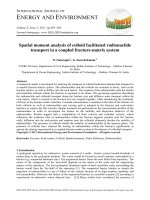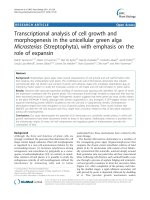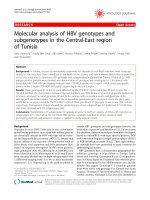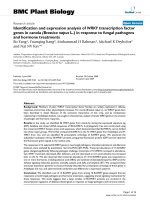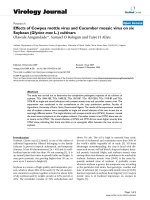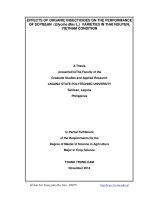Analysis of nitrogen fixation and transport in soybean (glycine max (l ) merr ) using nitrogen isotopes as tracer
Bạn đang xem bản rút gọn của tài liệu. Xem và tải ngay bản đầy đủ của tài liệu tại đây (1.63 MB, 106 trang )
ANALYSIS OF NITROGEN FIXATION AND TRANSPORT
IN SOYBEAN (Glycine max (L.) Merr.) USING NITROGEN
ISOTOPES AS TRACER
By
NGUYEN VAN PHI HUNG
A Dissertation Submitted to the
Doctoral Program of Life and Food Science,
GRADUATE SCHOOL OF SCIENCE AND TECHNOLOGY
NIIGATA UNIVERSITY,
NIIGATA UNIVERSITY
24 March 2014
Contents
………………………………………………………………
Content
1
Abbreviations ………………………………………………………………. 3
Chapter 1
Introduction…………………………………………………
4
1.1 Background of research….…………………………………
4
1.2 Literature Review…………………………………………… 8
1.3 Objective of this study………………………………………
Chapter 2
Materials and Methods……………………………………… 24
2.1 Plant cultivation……………………………………………..
Chapter 3
15
N2 fixation experiment ……………………………………. 26
2.3
13
N2 fixation experiment in soybean………………………
28
Quantitative Analysis of the Initial Transport of Fixed
15
N
as a
Tracer………………………………………………………
34
Visualization of initial transport of fixed nitrogen in
nodulated soybean plant using 13N2 tracer gas in real-time…
Chapter 5
24
2.2
Nitrogen in Nodulated Soybean Plants using
Chapter 4
23
57
Evaluation the effects of low partial pressure of O2 on
nitrogen fixation in soybean using a positron-emitting tracer
imaging system……………………………………………...
1
70
Chapter 6
General discussion…………………………………………..
81
Reference……………………………………………………………………..
87
Abstract ……………………………………………………………………...
98
Tables…………………………………………………………………………
101
Figures………………………………………………………………………... 102
Acknowledgement……………………………………………………………. 104
2
Abbreviations
ATP: Adenosine triphosphate
ADP: Adenosine phosphate
BAS: Bio imaging analyzer system
BNF: Biological nitrogen fixation
DAP: Day's after planting
DW: Dried weight
FOV: Field of view
GC: Gas Chromatography
GOGAT: Glutamate synthase
GS: Glutamine synthetase
Lb: Leghemoglobin
N2: Di-nitrogen
Ndfa: Nitrogen derived from air
Ndff: Nitrogen derived from fertilizer
Ndfs: Nitrogen derived from soil
NF: Nitrogen fixation
PETIS: Positron-emitting Tracer Imaging System
ROI: Region of interest
TAC: Time-activity curve
3
CHAPTER 1
INTRODUCTION
1.1. Background of research
Legume is a large group with about 18,000 species (Ohyama et al.,
2008a), of which soybean plant takes the important position because soybean
seed has one of the most important protein sources for human and livestock in
the world (Ohyama et al., 2013).
Nitrogen element is one of the most necessary nutrient elements that is
required for growth and development of every organism. This element also plays
an important role in plant life. Because soybean seed contains a high
concentration of protein, about 35-40% based on dry weight, so that soybean
plants need a large amount of nitrogen. It is estimated that one ton of soybean
seed requires 70-90 kg of nitrogen (Ohyama et al., 2008a). In soybean, nitrogen
usually derived from three sources; air, soil, and fertilizers, of which nitrogen
derived from atmosphere via symbiotic nitrogen fixation makes up from 60-75%
in converted paddy fields in Niigata (Takahashi et al., 1993a). Although N2 is rich
in air and accounts for about 78%, it cannot be utilized by eukaryotes, such as
plants, fungi and animals. Only some species of prokaryotic microorganisms can
use it directly from atmosphere via biological nitrogen fixation (BNF) process.
However, some legume species form root nodules and they can use atmospheric
4
nitrogen by symbiosis with nitrogen fixing microorganisms.
It is clear that BNF plays a major role in the plant life especially in
legume species, and under N deficiency conditions. Through a symbiotic
nitrogen fixation process, legume plants can use atmospheric nitrogen as a
nutritional source for their growth and development. It was estimated that 39x106
tons of nitrogen is fixed by legume species every year (The Nature and Properties
of Soils, 2002). Soybean plant has also the ability to fix dinitrogen (N2) from the
atmosphere in the root nodules and absorb nitrogen nutrition from either fertilizer
or soil. Soybean plants need a large amount of nitrogen nutrient to synthesize
seed storage protein especially in the pod filling stage, but the nitrogen nutrient
obtained from atmosphere is sometimes not enough at specific stages (Ohyama,
1983). Therefore, in order to get the highest yield and quality of soybean seeds it
is necessary to provide a large amount of nitrogen nutrient depending on the
requirement in various growth stages. The understanding of physiological
process of BNF and the transport of fixed-N are very important for improving
legume cultivation in order to increase crop productivity, promote the
contribution of BNF in soybean crop in each stage and provide enough nutrition
for growth and seed yield. Furthermore we can save the chemical fertilizers and
protect environment problem of N pollution.
Until now, there are many methods to be used to investigate nitrogen
fixation and transportation in plants such as the total nitrogen different method
5
(Gauthier et al., 1985), acetylene reduction assay method, ureide assay method
(Herridge et al., 1990). However, all these methods are indirect methods so that
they don't provide the real rate of nitrogen fixation and the information about
transport of fixed-N in living plants.
The methods using nitrogen isotope are considered to be the best tool
for studying of nitrogen fixation in plants. By using
15
N stable isotope,
researchers have found the pathways of nitrogen compounds assimilating and
transporting in plants. The results indicated that N2 is reduced into ammonia in
nodules and then assimilated through different pathways in legume species
(Ohyama and Kumazawa, 1978a). In soybean plant, it was found that ureides
(allantoic acid and allantoin)
are synthesized in nodules and transferred to the
shoots via xylem system (Matsumoto 1977), while the main transport forms of
nitrogen absorbed from roots were nitrate and asparagine (Ohyama and
Kumazawa, 1978 and 1979). All of N forms are considered to be transported to
shoots via xylem vessels, but major part of N forms from the roots was first
translocated in leaves and then re-distributed to pod and seed, while some parts
of the fixed N originating from nodules were directly moved to the pods and
seeds in addition to the leaves (Ohyama, 1980).
In addition, the positron-emitting tracer imaging system (PETIS), which
has been developed in recent decades, gave the outstanding analytical method in
the field of plant nutrition. PETIS system detects γ-ray generated by positron6
emitting nuclides and we can observe the movement of positron-emitting
radioisotopes in a living plant at real-time (Kume et al, 1997). This new
technique provided the visualization of the dynamic transport and allocation of
metabolites at large distance scales and consequently gave information for
understanding whole-plant physiological response to environmental change in
real time (Kiser et al., 2008). In the past decades, PETIS was used to study of
nutrient in plant such as carbon (C) in broad bean (Matsuhashi et al., 2005),
sorghum (Keutgen et al., 2005), soybean (Kawachi et al., 2011), eggplant
(Kikuchi et al., 2008), nitrogen (N) in soybean (Ishii et al., 2009, Ohtake et al.,
2001, Keutgen et al., 2002, Sato et al., 1999), in rice (Kiyomiya et al., 2001),
Orobanche sp. (Kawachi et al., 2008), cadmium (Cd) (Fujimaki et al., 2010;
Ishikawa et al., 2011), manganese (Mn) in barley (Tsukamoto et al., 2006), iron
(Fe) in barley (Tsukamoto et al., 2009), and Zinc (Zn) in barley (Suzuki et al.,
2006).
There are many studies in the field of nitrogen fixation and the transport
of fixed nitrogen in soybean plant, but the results are not much clear about the
rate of fixed-N from nodules and the transport of fixed-N to various organs of
soybean plant.
To elucidate the turnover rate of fixed-N in soybean nodules and
transport mechanism of fixed-N, this study used 15N2 and 13N2 isotopes as tracers.
7
1.2. Literature review
1.2.1. Biological nitrogen fixation and nitrogen nutrition demand in
soybean plant
Although nitrogen is dominant element on the Earth, but most of
organisms cannot use gaseous nitrogen (N2) directly from atmosphere except
some prokaryotic microorganisms. Some plant species can use atmospheric
nitrogen indirectly through BNF in a symbiotic process with these
microorganisms. Therefore, BNF is not only important for the growth and
development of legume plants, but also for nitrogen cycle in the global scale.
Legume plants can fix atmospheric di-nitrogen via symbiosis with soil
bacteria, rhizobia. Because of its importance, the process of BNF has been
studied intensively for a long time. The studies of BNF may promote crop
production to improve the yield of grain crops for food and livestock when the
population of the world is increasing rapidly. Furthermore, the use of chemical
nitrogen fertilizer for crop cultivation is very large, estimated about 100 x 106 ton
in 2009 (Ohyama et al., 2010), an excess or improper use of the chemical
fertilizers sometimes resulted in pollution of soil and underground water.
Research efforts to improve the nitrogen fixation activity in legume crops not
only increase the crop production and the income for famer, but also decrease the
environmental pollution.
8
Soybean plant is one of the most important legume crops and is the
fourth largest grain crop after rice, wheat and maize. Soybean seeds contain a
high concentration of storage protein (approximate 40% of dry weight), therefore
providing a large amount of nitrogen is necessary to get high yield and high
quality seeds. One of the most important characteristics of soybean plant is that it
can also use nitrogen source indirectly from atmosphere in the symbiotic process
with bacteria, rhizobia, N2 fixing soil as well as soybean can absorb combined
nitrogen such as mineralized N from soil or fertilizer N (Ohyama et al., 2010).
In the process of BNF, rhizobia obtain carbohydrate from a host plant
and they fixe atmospheric N2 to NH4+ in the root nodules, and then they give
fixed NH4+ to the plant cells, and ammonia is assimilated into N compounds such
as amino acids and ureides (Russelle, 2008). In soybean nodules, the major fixed
ammonia is excreted to cytosol in infected cells, and then it is assimilated into
amino acids via glutamine synthetase/glutamate synthase (GS/GOGAT) (Ohyama
and Kumazawa, 1978b). The previous results indicated that a major part of fixed
nitrogen is assimilated into ureides, allantoin and allantoate by de novo synthesis
and transported from nodules to shoots via xylem system (Ohyama, 1981).
The symbiotic nitrogen fixation activity is influenced by many biotic
and abiotic factors (Sprent and Minchin, 1983). The nitrogen fixation rate is
highest at the end of flowering and during the pod filling (Harper, 1974). It has
been determined that the increase of soybean yield was related to the increase of
9
the amount of fixed nitrogen and total N derived from atmosphere (Herridge and
Bergersen, 1988). It is estimated that the average of fixed nitrogen in soybean
was 75 kgN ha-1 (LaRue and Patterson, 1981), but in good condition it could
reach to 300 kgN ha-1 (Keyser and Li, 1992), and the BNF can supply more than
50% of the total N requirement for the whole life. It is clear that BNF is very
important for agricultural system, especially at nowadays when pollution and
climate change are increasing day by day then limited use of chemical fertilizers
and increased use of organic fertilizers, especially increasing the ability of BNF
of tree crops are one of the best ways to protect our planet.
1.2.2. Mechanism of biological nitrogen fixation
The process of BNF in legume plant is taken place in root nodules.
First, the host plant roots excrete the phenolic compounds such as daidzein and
genistein in soybean plant (Charrier et al. 1995, Shirley 1996, Bladergroen and
Spaink 1998) signal molecules to attract rhizobia and stimulate the expression of
nodulation genes (Nod-genes). When rhizobia habitat in root system they will
induce the formation of nodules after trapped by hair root curling. During the
root curling process, rhizobia are entrapped in the loop of root hair and they
proliferate, and move through the infection thread toward the inner cortex of root
to form a nodule in the inner root cortex (Figure 1.1)
10
Figure 1.1: The infection process through the root hairs and the simultaneous
formation of the nodule (Debell´e, F., et al., 1986).
Soybean nodules appear about 10 days after sowing when the seeds are
inoculated with a compatible rhizobia, and they reach 3 mm in diameter after 20
days cultivating (Ohyama et al., 2010). The soybean nodule is structured by
many layers (Figure 1.2), there is the symbiotic region in the center, which
consists of the mosaic of small uninfected cells and large infected cells. The
infected cells contain O2 binding protein "leghemoglobin (Lb)" that keep an
important role in in protection of nitrogenase and maintenance of respiration to
11
provide ATP in nodules (Ohyama et al., 2008b). Nodule cortex layer is
surrounded the internal symbiotic region that has a function in regulating O2
permeability for nitrogen fixation process in order to adapt high or low O2
concentrations.
Figure: 1.2 Model structure of soybean root nodule (Ohyama et al., 2008).
The atmospheric nitrogen fixation is conducted based on the catalysis of
nitrogenase enzyme in three steps (Rees et al., 2005). First, the Fe-protein of
nitrogenase reduced by electron carriers such as flavodoxin and ferredoxin and
then, single electron is transferred from Fe-protein to Mo-Fe protein in Mg-ATP
dependent process. Finally, the electron is transferred to the substrate, which
already bound to the active site of Mo-Fe protein complex and the cycle is
12
repeated until sufficient electrons and protons form to reduce the substrate.
N2 + 16ATP + 8H+ + 8e- → 2NH3 + H2 + 16ADP + 16Pi
The energy used in this process is obtained from the host plant. The
initial product of nitrogen fixation process is known as ammonia (Ohyama and
Kumazawa, 1978b). It has been found that more than 90% of fixed nitrogen in
soluble fraction is ammonium only after soybean nodules were exposed to
15
N2
gas to soybean nodules (Bergersen, 1965). A high concentration of ammonium is
poisonous to plant cells, so that it should be immediately converted to amino
acids (Day et al., 2001).
Two enzyme glutamine synthetase (GS) and glutamate synthase
(GOGAT) operate in tandem to form glutamate synthase cycle of ammonium
assimilation (Figure 1.3) (Lea, 1997).
In the glutamine synthase pathway, glutamate is converted into
glutamine with ATP-dependent catalyzed by GS:
Glutamate + Ammonia + ATP → Glutamine + AMP + Pi
This reaction requires divalent cation, such as Mg2+, Mn2+ or Co2+ as a cofactor.
Next, the GOGAT catalyzes the reaction between glutamine and 2-oxoglutarate
to convert glutamine into glutamate:
Glutamine + 2-oxoglutarate + 2e- → 2 glutamate
13
Asparagine Arginine Ureides
Tryptophan
Nucleic acids
Histidine
2-Oxoglutamate
Glutamine
NO3
3
N2
Synthase cycle
The glutamate
NH
Glutamate
Glutamate
Photorespiration
Proline
Asparagine
Amino acids
Arginine
2-Oxo acids
5-Aminolevulinate
Chlorophill
Urea
Figure 1.3: The assimilation of ammonia in higher plants via the glutamine
synthetase/glutamate synthase cycle (Lea, 1997).
By using
15
N2 experiments, it has been demonstrated that the
15
N
abundance of ammonia initially increased and reached the maximum value
rapidly after a few minutes of 15N2 exposure. This suggested that there were more
than one compartment of ammonia in nodules and the ammonia pool may be one
of which directly derived from nitrogen fixation (Ohyama and Kumazawa,
1978b, 1980). The glutamine increased highest until 10 minutes of 15N2 exposure
but not continue afterward and it seem to be synthesized near the site of N2
14
fixation (Ohyama and Kumazawa, 1978b). All
15
N incorporated compounds are
transported immediately to organs of soybean plant via xylem system.
1.2.3. Transport of fixed nitrogen in soybean plant
As mentioned early, after N2 is fixed, the fixed-N is exported
immediately from bacteroid to cytosol and assimilated by GS/GOGAT pathway
to glutamate and metabolized to various amino acids (Ohyama et al., 2008b). In
soybean plant, a major part of fixed-N is metabolized to ureides (including
allantoin and allantoic acid) in nodules through de novo synthesis, so that they
are considered as the main nitrogen compounds transported from soybean
nodules to other parts (McClure and Israel, 1979; Ohyama et al., 1989b).
The main transport route of fixed N from the nodule to the shoot is
considered via xylem system, as well as the transport of absorbed nitrate (NO3−)
in the roots. Previous 15N tracer experiments comparing 15N2 fixation and 15NO3−
absorption indicated that some portions of N, which originated from N2 fixation,
were translocated directly to the pods and seeds in addition to transportation to
the leaves (Ohyama, 1983). On the other hand, nitrate nitrogen (NO3-) was
primarily transported to the leaves then re-transported to the pods and seeds. Pate
et al. (1979) reported that, in white lupin (Lupinus albus L.), 68% of the N
received by leaves from xylem was re-exported from the leaves with
15
photosynthates via phloem system, and that 48% of N incorporated into the
growing nodule was supplied from the shoot downward via phloem, this
recycling N is very important for roots and nodules growth for their N nutrition.
However, the rate of recycling N from the shoot to the roots has not been
investigated in nodulated soybean plants.
Based on the obtained results, Ohyama et al., (2008a) assumed
conclusion for the fixed nitrogen transport described by the model following:
Figure 1.4: Model of transport of N from N fixation in soybean plant (Ohyama et
al., 2008).
16
The Figure 1.4 shows the transportation of fixed nitrogen in soybean
plant, the fixed N from nodules as the forms of allantoin and allantoic acid is
translocated to the upper parts including shoots, leaves and pods via xylem
system and re-distributed to pods, roots via phloem system (Ohyama et al.,
2008b). First, fixed ammonia is incorporated into amide group of glutamine and
then into glutamic acid and allantoin and allantoic acid. There are two main
pathways of fixed N transport to be distributed. One, the fixed N is carried from
root nodules up to shoot in the xylem. The other major flow path is that fixed N
moves from mature leaves to growth and storage organs in the phloem system.
1.2.4. Measurement of biological nitrogen fixation
Up to today, there are several methods used to measure NF rate in crops,
but no one can provide an accurate measure of NF for all legume species under
diversely environmental conditions. Each method has its own advantages and
disadvantages (Peoples et al., 1989). In general, there are several approaches for
estimating NF in legume plants. The first is to estimate the NF activity based on
the increase in total N of plant and soil system (N balance method). The second is
to separate plant nitrogen into the fraction derived from soil and atmosphere such
as N difference, 15N abundance, 15N isotope dilution and relative ureide methods.
The last is to measure the activity of nitrogenase that is responsible for N2
17
fixation such as acetylene reduction and hydrogen evolution methods (Unkovich
et al., 2008). Some of which will be described briefly in the following sections.
1.2.4.1. 15N stable isotope method
The
15
N isotope method is one of the most reliable methods used to
investigate the contribution of BNF to legume crops using
15
N-labeled gas or
nitrogen
15
N labeled fertilizers (Pauferro et al., 2010). It based on the principle
that the
15
N/ (14N +
15
N) molar ratio of the atmosphere is 0.364%, thus the
contribution of biological nitrogen fixation is
supplied either calculated from with the
15
N2 or
15
N/14N ratio in plant tissue
15
N2 fertilizer or soil (Danso,
1995). Depending on each technique and condition to be applied, the 15N method
may be classified into:
1)
2)
15
N2 isotope gas method
15
N isotope dilution method
3) The A-value method
15
N2 labeled gas method was applied to study nitrogen fixation long
time ago. In this method, nodulated plants were incubated in 15N2 labeled gas, the
15
N abundance in the plant tissue of fixing plants will be significantly higher than
that of the natural abundance in air or soil. This method uses
15
N isotope gas
directly to treat legume plants in laboratory condition in order to detect BNF.
18
However, the environment within the chamber is different compared that of in
the field and plants were treated with
15
N2 only a short time. Therefore, the
results obtained from such experiments usually applied for short-term
15
N2
feeding experiment and it is difficult to use for the long-term experiment during
entire growing season (Knowles, 1980). Although it is very sensitive and precise,
this method cannot be applied in the field because plant roots need to be enclosed
in an air-tight system.
1.2.4.2. 13N radioisotope method
Nitrogen-13 is a radioisotope of nitrogen with short half-life only 9.97
minutes. It has been applied in positron emission tomography (PET). One of the
advanced methods employed 13N in the field of plant nutritional study developed
recently was positron-emitting tracer imaging system (PETIS). This method can
overcome the obstacle that previous methods could not perform. PETIS method
was used relatively wide to study of nutrients in plants such as wheat
(Matsuhashi et al., 2006), barley (Suzuki et al., 2006, Tsukamoto et al., 2006),
eggplant (Kikuchi et al., 2008), soybean plant (Ishii et al., 2009; Ohtake et al.,
2001). Besides, PETIS is also used to investigate the pollutant metal accumulated
in food crops such as rice (Fujimaki et al., 2010; Ishikawa et al., 2011). Recently,
by applying mathematical models in quantifying of radioisotope activity in time
course, the rate export and import of labeled elements were calculated broad bean
(Matsuhashi et al., 2005), soybean (Ishii et al., 2009; Keutgen et al., 2002).
19
The PETIS apparatus (Hamamatsu Photonics, Hamamatsu, Japan) used
in studying of plant nutrition has two head detectors that are opposite with each
other (Figure 1.5). The detectors consist of arrays of scintillators and
photomultipliers, which detect γ-rays and export spatial information of the
incident points on the head surface. The test plant will be placed in the center
between two head detectors at a distance of 10 cm to each detector head. PETIS
system can detect γ-rays created by positron-emitting nuclide and can observe the
movement of labeled elements in living plant in real time (Kume et al., 1997),
and this technique provides the capacity to visualize the dynamic transport or
allocation of metabolites at scales of centimeters and consequently gives
information
for
understanding
whole-plant
physiological
response
to
environmental change in real time (Fujimaki 2007; Fujimaki et al., 2010;
Kawachi et al., 2011). The detection of γ-rays from the annihilation of positron is
possible to be tracked the transport and distribution of radiotracers in test plant as
a function of time.
20
Figure 1.5: Diagram of two head detectors (Courtesy of Dr. Shu Fujimaki, JAEA).
PETIS method is a non-invasive technique, which allows the
visualization and assessment of radioactive tracers in sample plants without
destroying. Therefore, the sample plant can be used repeatedly many times under
the same environmental condition. The repetitive measurement on the same plant
makes it possible assessing of biological variances of an individual plant.
To investigate the BNF activity and N assimilation in PETIS
experiment, plants are treated with
13
N-labeled tracers (13N2,
13
NH4+ or
13
NO3-).
The radioactive nucleus decays with emitting a positron (e+) and neutrino ().
The positron will travel through the material, losing energy by collisions with
21
electrons (e−). Once the positron reaches thermal energies it annihilates with an
electron, which results in two 511 keV gamma rays (γ) emitted in opposite
directions (Figure 1.6).
Gamma rays are attenuated very little by test plant tissue and detected
by two head detectors. PETIS system will reconstruct an image of the twodimensional distribution of the tracer and the image will be used for estimating
accumulation and transport of the N tracer in plant.
Figure 1.6: Diagram of positron annihilation (Jens Langer, 2007).
22
1.3. Objectives
The objectives of my research were as follows:
1) Quantitative analysis of the initial transport of fixed nitrogen from nodules and
transport and distribution of fixed-N in various organs by pulse-labeled
15
N2
experiment.
2) Visualization of the initial transport of fixed nitrogen in nodulated soybean
plant using 13N2 tracer gas and PETIS in real time.
3) Studying of the effects of O2 partial pressure in rhizosphere on nitrogen
fixation activity and transport of fixed 13N2 in soybean using PETIS.
23
Chapter 2
MATERIALS AND METHODS
In this chapter, the general methods will be described and the detail
used in specific experiment will be addressed in the corresponding chapters.
2.1. Plant cultivation
2.1.1. Seed germination
Soybean (Glycine max [L.]Merr. cv. Williams) seeds were sterilized
with 70% ethanol for 30 second and sodium hypochlorite solution with 5g L-1 of
available Cl for 5 min and then thoroughly washed with deionized water. The
seeds were inoculated with the suspension of Bradyrhizobium japonicum (strain
USDA 110) and sown on a vermiculite tray. Ten days after sowing, the seedlings
with primary leaves expansion were transferred to 1 L glass bottle containing 800
mL of nitrogen-free nutrient solution or plastic containers containing 20 L of
nitrogen-free nutrient solution (Fujikake et al., 2002). The nutrient solution was
changed periodically depending on each experiment, usually three times a week.
The solution was continuously aerated by an air-pump.
24

